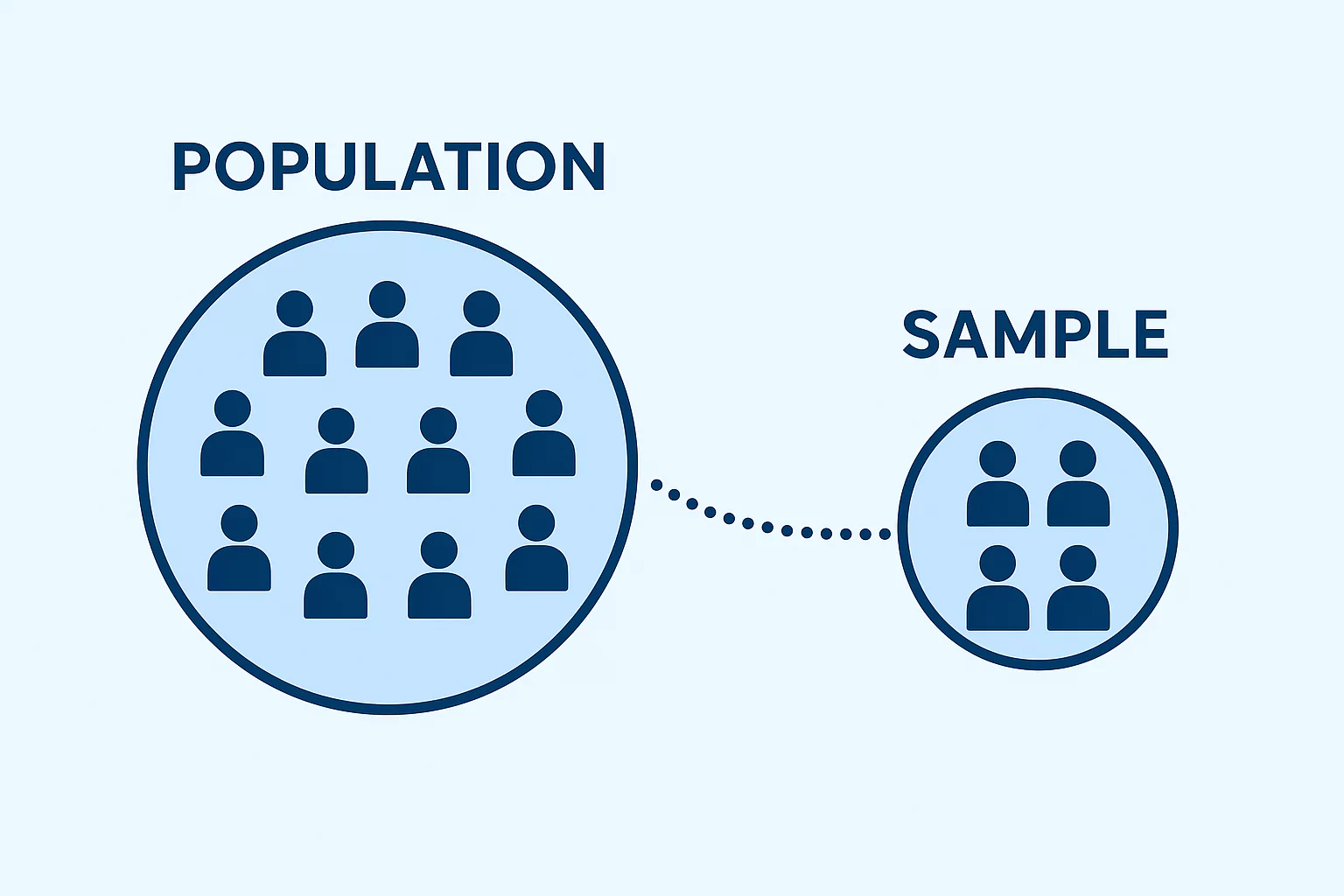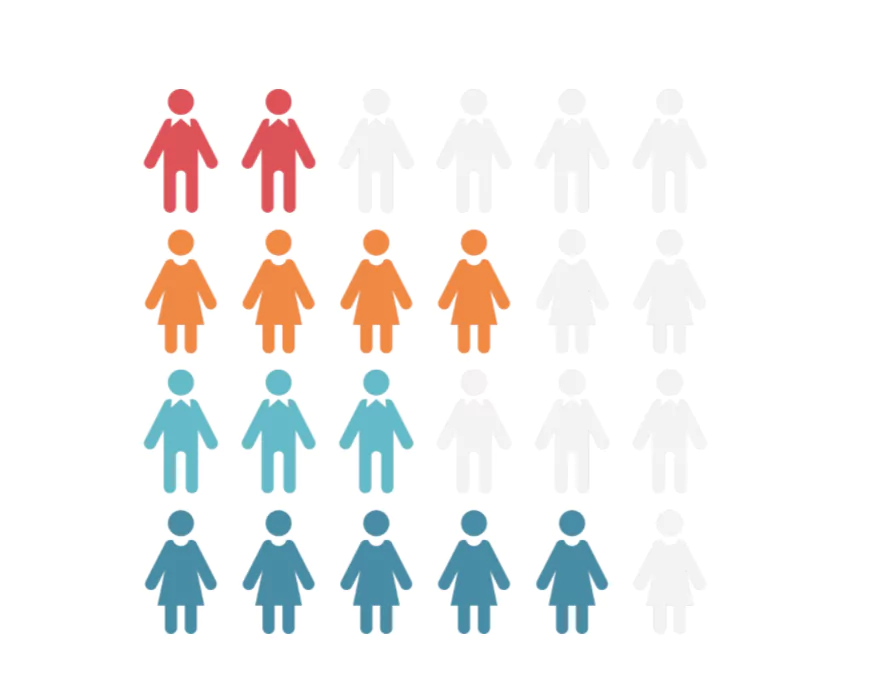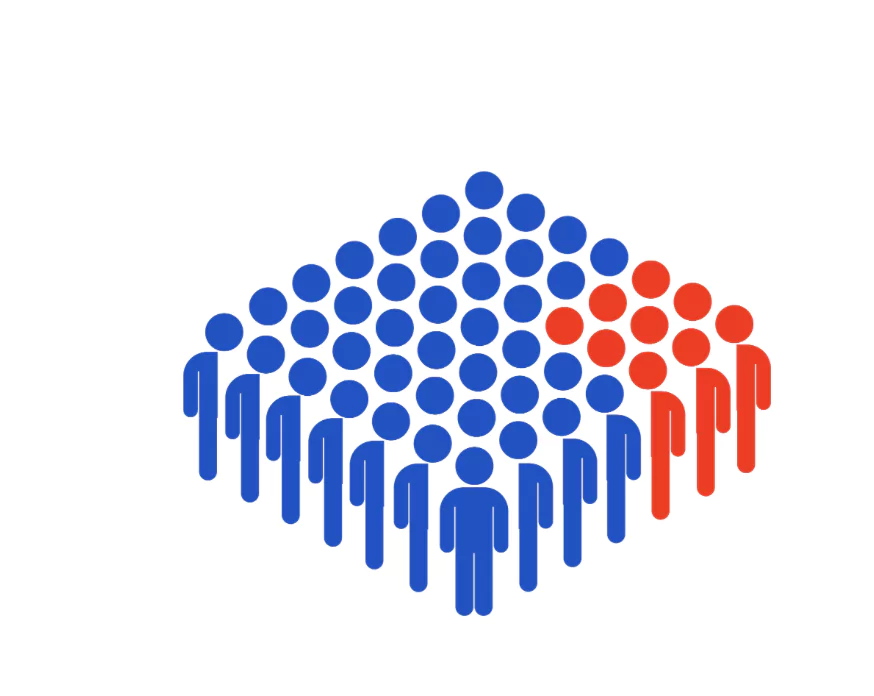Population vs Sample is a common point we often came to hear during the analysis process. In research, the population is not always something used to refer to people. It can also mean a group of elements of anything you want to study. It can be objects, events, organizations, countries, etc. A sample can be a group of data that you choose to process during your research.
In this blog, we will understand the complete difference between population vs sample with their examples and how population is different from a sample. Read along to clear up every confusion regarding the sample and the population.
What Is Population?
The population refers to the entire group that you want to draw conclusions about. It is not necessary that ‘population’ always means people (in research); it can also mean objects, organisations, events, or anything you wish to conduct research on or draw conclusions from.
It is a complete set of individuals or items that you want to study. For example, if you are researching the average height of students of a particular school, then the population is the total number of students studying in that school. If you study the population, it may give accurate results, but it takes a lot of time and effort.
Read More: What is Exploratory Data Analysis?: Complete Explanation For Beginners
What Is A Sample?
A sample refers to the specific group of data that you collect or choose to proceed with your research. The size of the sample is always less than the size of the population. A sample is a part of the population.
For example, there are 50 biscuits in a packet, and you randomly select 5 biscuits to test their quality. In this case, the total number of biscuits is the population which is 50 and the sample is 5 biscuits (part of the population that you’ll study).
Population Vs Sample: A Clear Context

The population is a complete group, and the sample is a part of that group that you are studying or will perform your research on. Let’s understand clearly, with the help of a table, the complete difference between population vs sample.
|
Population vs Sample |
|
| Population | Sample |
| Everyone working at Google worldwide | 200 Google employees who responded to an online survey |
| All movies released on Netflix in 2024 | 50 random movies selected for reviewing audience ratings |
| All Apple mobiles sold in 2024 worldwide | Apple mobiles sold in India in 2024 |
| All high school students in India | 500 students from 10 schools in Delhi were selected for career interest survey. |
- Population: The whole group you want to study.
- Sample: A part of that group from which you actually collect data.
Read More: An Overview of Data Analysis Process: Important 6 Steps Guide
Collecting Data From A Population
Collecting data from a population is better and easier, especially when your data is small and you have access to every member of the population and can collect data from every person. Population is used when your research question requires data from each member of the population.
It is one of the most straightforward methods to collect data from a whole population when it is less and easily accessible. When the data of the population is very large then it becomes difficult to analyse it because it is unrealistic to collect data from 1000s of members.
| Method | Overview |
| Census | Census involves collecting data from every individual or item in the population. It provides one of the most complete and accurate information, but it might be costly and time-consuming. |
| Administrative Data | It can use existing records from government agencies or organisations, such as census reports, tax records, healthcare files, or school databases. |
| Surveys | Questionnaires or interviews are conducted to gather data. They provide insights into opinions, behaviors, and demographics. |
| Direct Observation | Researchers observe and record behaviours or events directly in natural environments. It is widely used in anthropology, sociology, and ecology to capture real-world actions. |
| Remote Sensing | We can use technologies like satellites, drones, or sensors to collect data about large, especially remote areas. |
| Social Media and Web Data | Data can be collected and analysed from platforms like Twitter, Facebook, or websites to understand behaviours, trends, and digital interactions of populations. |
| Physical Measurements | Physical measurement involves measuring physical or biological attributes of individuals or objects i,e. height, weight, temperature, and chemical properties. |
Let us understand population vs sample differences with a simple example for population based data. Consider a city hospital wants to study the vaccination status of all children under the age of 5 in the city. Since the hospital wants to draw conclusions only about children within a particular city and below 5 years of age, they will collect data from the entire group. In this case, the population includes every child below the age of 5 living in that city.
When Data Collection From the Population preferred?
Data collection from the Population vs sample is something that comes to mind when dealing with a large dataset of data. Well, when accuracy is priority, covering the entire population, then it is best to collect data from the complete population rather than just a sample.

When collecting data from the entire population can provide the best insights, and having the right budget and permission to collect data from the entire population, then going ahead with population data is much better. Also, collecting samples from the population can avoid the bias introduced by sampling methods. When you collect data from the entire population, then the bias problem gets eliminated.
Collecting Data From A Sample
Collecting data from a sample becomes necessary when your population is large in size, widely dispersed, or difficult to contact. Sample data is a part of the population, from which you can make estimates and test hypotheses about the population data. It is easy to analyse a small set of data and draw conclusions from it as compared to large datasets.
While analysing a sample, the data or items should be selected on a random basis from the population, so it represents the whole population, and the results are more accurate and reliable. Probability sampling methods like simple random sampling or stratified sampling are considered best for this, but actually, researchers often use non-probability sampling methods because it is quicker, cheaper and easier to access.
- Random Sampling: Every member has an equal chance of getting selected.
- Stratified Sampling: The population is divided into two subgroups, and then samples are taken from each group to ensure inclusion of all types.
- Non-Probability Sampling: No random selection is done, samples are taken based on convenience or specific criteria.
For example, a company wants to study and understand the job satisfaction of its employees. The total number of employees is 20,000 working across different branches in India. Since the number is too big and it is impossible to survey everyone, the company selects 400 employees (sample) from offices in 4 major cities to fill the questionnaire.
Why Is the Sampling Method In Analysis Important?
Sampling is the method of selecting a subset of the complete population for study purposes or analysis. It involves choosing certain items to represent a larger group. It is a smaller part of the complete population studied or analyzed to make assumptions for different groups.

Sampling is often more practical as it is impossible to study the entire population due to various factors like cost, data constraints, and more. Also, in population vs sample collecting data in sampling is way more efficient when compared to the complete population analysis. Sample methods are often more accurate. It eliminates the problem of the excess of permits required to study the entire population.
![]() Join Our Data Analytics Telegram Channel
Join Our Data Analytics Telegram Channel
![]() Join Our Data Analytics WhatsApp Channel
Join Our Data Analytics WhatsApp Channel
Parameter of Population vs Sample Statistic
The population parameter is a numerical value that describes the characteristic of the whole population. A sample statistic is a numerical value that describes the characteristic of a particular sample used to estimate the population parameter.
Let’s understand the complete difference between population vs sample better with the help of an example. You conduct a survey to study the sleeping habits of college students. You ask the participants in the survey how many hours they sleep every night. From your sample of 400 students, you find out that the average sleep duration is 6.5 hours. Now, 6.5 is the sample statistic which you can use to estimate the population parameter.
- Parameter: describes the whole population (the truth)
- Statistic: describes the sample (our estimate of truth)
Read More: Market Analysis: What It Is and How to Conduct One
Examples of Population and Sample
You can check out some of the examples of population and sample to understand the difference between population vs sample clearly.
- Population: All 10,000 students in the different schools of Delhi, Sample: 500 students selected from the 5 top schools to research studying habits.
- Population: All adults living in Mumbai, Sample: 1000 adults chosen from different neighbourhoods to check the average blood pressure.
- Population: All the customers who purchased at least something from Amazon in India in 2024, Sample: 2000 customers whose feedback you collected through an online survey.
- Population: Each cricket player who is registered in India, Sample: 50 players selected for a training camp to check fitness levels.
Population vs Sample: Difference Table

Check the difference table for population vs sample to understand the major context between these two processes.
| Population | Sample |
| The population consists of the entire set of individuals, items, or data points that you want to study in an analysis or stats. | A sample is a comparatively smaller, selected group taken from the complete population to represent it in analysis. |
| It is usually very large, sometimes infinite i,e. Not feasible to measure. | It is much smaller and manageable i,e. Typically, a fraction of the entire population. |
| It includes complete information about every member of the group. | It includes only partial or important information, totally focused on selected members of the group. |
| It is time-consuming and expensive | It is less expensive and faster. |
| It provides the exact and complete results if the full data can be obtained. | It provides an estimate that is close to population results but may contain sampling error. |
| It is not feasible or impossible to conduct in many cases, such as measuring the income of every citizen in a country. | It is a very practical approach and widely used in analytics when population data is unavailable. |
| It is used when a full census or complete dataset is needed. | It is used to make inferences, predictions, and generalizations about the population. |
| The complete process can be highly complex due to the massive data size. | The method of sampling is simple and efficient to analyse and work with due to the reduced dataset size. |
| It requires big data tools, such as Hadoop, Spark, distributed databases, etc, to handle huge populations. | It can often be managed with traditional tools (Excel, SQL, Python, R). |
| The population is never biased when data is properly recorded and managed. | Samples might be biased in some cases. |
Also Read:
- Top 20 Data Analytics Companies In India
- Unstructured Data: 5 Important Characteristics You Shouldn’t Ignore
- Data Intelligence: What It Is and Why It Matters in 2025
- What is Augmented Analytics? Learn How It’s Changing the Data Game in 2025
Learn Data Analytics With PW Skills
Become a master in handling data with PW Skills 6 Months Data Analytics Course for beginners as well as working professionals. Learn powerful tools like Python, MySQL, Power BI, AWS, Jupyter, etc from industry experts.
Gain knowledge of Machine Learning, excel, statistics, and more within this course. Work on diverse project portfolios, practice exercises, and module level assignments with this course.
Population vs Sample FAQs
Q1. What are the population vs sample differences?
Ans: The population refers to the entire group that you want to study, it can be people, items, events, organizations, etc, whereas a sample is a part of the population that you select to study and draw conclusions.
Q2. When are populations used in research?
Ans: Populations are used in research when your research requires data from every individual or from every member of the population. It is only easy and convenient when the population is small and easily accessible.
Q3. What is the difference between a parameter and a statistic?
Ans: A parameter describes the measures of the population, whereas a statistic describes the measures of the sample.
Q4. Which method is best for sampling?
Ans: Probability sampling methods like simple random sampling and stratified sampling are considered the best, but researchers often use non-probability sampling because it is quicker, cheaper, and easier to access.

